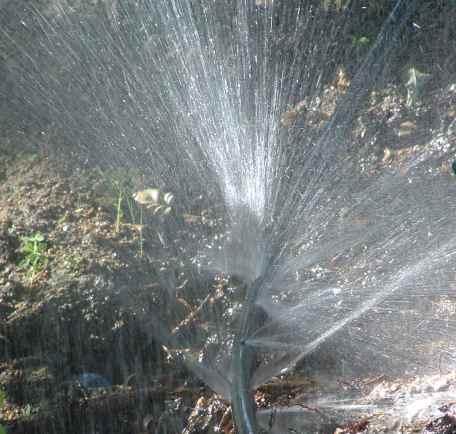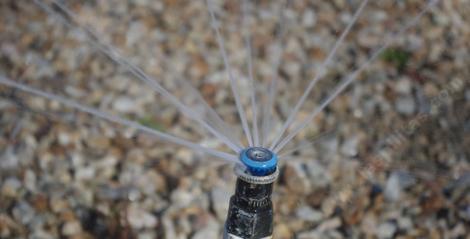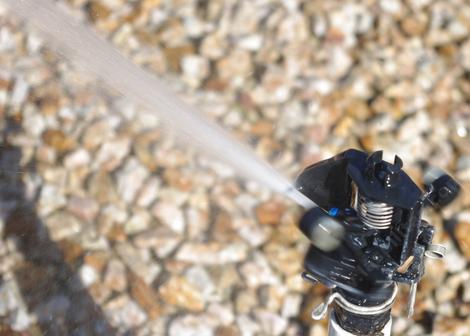Sprinklers and California native plants
Do you really need a sprinkler system?
We stopped installing systems back in the early 1980's because everyone kept overwatering. A customer with the hose seemed to be safer than a sprinkler system that could be turned on easily.
The best watering seems to be an owner with a a hose and a cup of. You can water as much as you wish as long as there's something in your cup, or can, and you do not set the hose down. Some owners like coffee, tea, beer or wine, the plants prefer a wash down with water. In other words a 15 minute wash down once a week sees to help the owner and the plants.
But for larger areas or owners that are seldom there we use very low volume sprinklers. We do not recommend drip for most native plants. It is fine for natives that grow in ponds. Your can read more about drip irrigation on the Drip Page
The Basics of a sprinkler system.
Installing Valves
Ok, I'm not going to get into real details. Every property is different and may need a different approach.
But here are some of the basics to figure out as you lay out the system.
You'll need an antisiphon valve as close the the water main as possible. If you need more than one valve, put a stainless steel ball valve between your valves and the main. I like using brass or galvanized according to the metal you are connecting to. After that ball valve you can use plastic. With the ball valve you can shut down the valve(s) when they are stuck open.
Choosing Sprinkers: These are some of the common sprinklers.
The lower volume(precipitation rate) sprinklers allow the water to penetrate the soil better, and we prefer them for washing off the dust. BUT, you'll need to have a timer that waters in the early morning with no wind. I'll not get into timers here, they are pretty straight forward.
There are some fancy sprinklers that do smaller flower beds and corners. Draw out your yard, measure each 'box' and find sprinklers that fit the patterns of the yard. Try to have little over spray, the spray that hits the car, sidewalks, walls. Make sure that the spray from one sprinkler reaches the next sprinkler or you'll have dry spots.
Ok, now count your sprinkler heads in the 'plan'. How many gallons per minute do you need?
Add up the heads and you'll have your gallons per minute.Approximate gallons per head(I prefer the microsprinklers or the mp series sprinklers)
Rainbird 1800 or A17-F full circle 2.4 gallons/m quarter circle .6 gallon/minute 15 feet radius
Toro 570 full circle, 3.7 gallons/minute; half circle, 1.8 gallons/minute; quarter circle, 1 gallon/minute 15 feet radius
Rainbird MaxiBird 2.4 gallons/min (doesn't matter if it's a qurter of full circle) 36 foot radius
Mp-1000 full circle .8 gallons/minute; quarter circle .2 gallon/minute 14 feet radius
Mp-2000 full cycle 1.7 gallons/min; quarter circle .45 gallon/minute 20 feet radius
MP-3000 full cycle 4 gallons/min ;quarter circle 1 gallon/minute 30 feet radius
Microsprinklers are about .5 gallons/min 6-8 foot radius quarter circle .5 gallon/minute
Connecting your valves and sprinklers
Ok, say you have 6 mp-2000's in half circle, and 4 in quarter circle. So, 6X.9+4X.45= 7.2 gallons/min.
On the next chart you can
see that one valve and ¾ pipe should be able to run 8-10 gallons
per minute. If your 'plan' calls for 24 gallons a minute you'll need
three valves. If you have a shady area and sunny areas try to break the
valves up so the shade plants are on one valve. Likewise if some plants
9a lawn) need more water give them a different valve than your cactus
garden.
Basic pipes
|
Pipe size(sch 40 pvc or polyeth) |
My recommended maximum* |
Possible with no problems |
|
1/2 |
5 gal/min |
5 gal/min |
|
3/4 |
8 gal/min |
10 gal/min |
|
1 |
12 gal/min |
16 gal/min |
|
1 1/4 |
22 gal/min |
28 gal/min |
|
1 1/2 |
30 gallon/min |
40 gallon/min |
|
2 |
50 gallon/min |
60 gallon/min |
|
2 1/2 |
75 gallon/min |
80 gallon/min |
*If you use the lower number you generally do not need to count the fittings.
A ¾ inch antisiphon valve can deliver about 15 gallons/minute. If your pressure is low(you can stop the hose with your thumb) you may only be able to get 6-8 gallons/minute out of the valve.
You can use poly, sch 40 or class 200 for your pipes. I prefer sch 40 pvc. Use fresh glue, primer is not needed(may make the joints weaker). Bury your pipes at least a foot deep or you'll be repairing them later. Bury them at three foot and you'll hate yourself before you finish. If your stomach isn't flat before the job, with three foot ditches, it will be flat.
All that really matters in a sprinkler system is that you are covering the ground(or plant foliage) evenly and you do not try to get more out of the pipe than it can deliver. If there is a question of what the pipe you are plumbing into can deliver, turn off the water, put your ball valve on, turn water back on. Turn on ball valve with bucket under it, time it. That's not perfect, but it will give an idea of what is in the pipe.If you can't figure out how to put the ball valve in, call a professional. Before or after.





